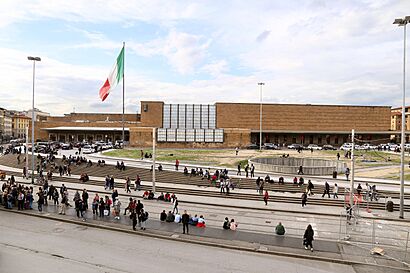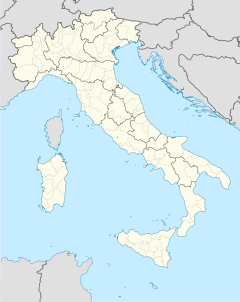Firenze Santa Maria Novella railway station facts for kids
Quick facts for kids
Firenze Santa Maria Novella
|
|
|---|---|

View of the station building.
|
|
| Location | Piazza della Stazione 50123 Florence Italy |
| Coordinates | 43°46′34″N 11°14′53″E / 43.77611°N 11.24806°E |
| Owned by | Rete Ferroviaria Italiana |
| Operated by | Grandi Stazioni |
| Line(s) |
|
| Distance | 314.077 kilometres (195.158 mi) from Roma Termini |
| Platforms | 15 |
| Construction | |
| Architect | Gruppo Toscano |
| History | |
| Opened | 1848 |
| Rebuilt | 1934 |
| Location | |
Firenze Santa Maria Novella (which means Florence Santa Maria Novella in English) is the main train station in Florence, Italy. It is also called Stazione di Santa Maria Novella. This station is very busy, with about 59 million people using it every year. It is one of the most used train stations in all of Italy.
The station is important for many train lines. It is at the northern end of the high-speed train line to Rome. This line was finished in 1992. It is also at the southern end of the train line to Bologna, which opened in 1934. A newer, faster train line to Bologna opened in 2009. Many local trains also use this station. They connect Florence to cities like Pisa, Livorno, Lucca, Viareggio, and Faenza.
Contents
History of the Station
Early Beginnings (1848)
The first train station here opened on February 3, 1848. It was built to serve trains going to Pistoia and Pisa. Back then, it was called Maria Antonia. This name came from the railway line itself, which was named after Princess Maria Antonia of the Two Sicilies. This first station was much closer to the famous Santa Maria Novella church than the building you see today. After Italy became one united country, the station was renamed after the church.
Designing the New Station (1930s)
In 1932, people started talking about building a new, modern train station. A famous sculptor from Florence, Romano Romanelli, wrote in newspapers about his ideas. This led to a big discussion about the best design. In the end, a plan by a group of architects called the Gruppo Toscano (Tuscan Group) was chosen.
The Gruppo Toscano designed the station in 1932. The building was constructed between 1932 and 1934. Famous architects like Giovanni Michelucci were part of this group. Some people thought the building's shape, when seen from above, looked like a symbol used by the government at that time. However, this shape was also influenced by the way the older station was already laid out.
Modern Architecture and Features
The station is a great example of modern Italian architecture. It was a very new and bold design for its time. The competition to design the station was quite debated. But when the government leader approved the Gruppo Toscano's plan, it showed that modern design was being accepted. The new station was built to replace the old Maria Antonia Station. It was also meant to be an impressive entrance to the city center of Florence.
The Gruppo Toscano only designed the main front part of the station. Other parts, like the platforms, were designed by another architect, Angiolo Mazzoni. Next to the station, there is also a white marble building called the Palazzina Reale di Santa Maria Novella. This building was made for the royal family when they visited Florence.
The station uses a strong stone called pietra forte for its front. This stone was chosen to match the nearby Gothic architecture of the Santa Maria Novella church. Inside, the station has a cool metal and glass roof with big skylights. These skylights cover the main area where passengers walk. They make the space feel very open and large.
Near platform 16, there is a statue and a special plaque. This memorial remembers the many Jewish people who were taken away from Italy by train during World War II.
Train Services
The station offers many train services, including high-speed trains that connect Florence to major cities across Italy.
High-Speed Train Routes
- Frecciarossa trains travel from Turin to Milan, Bologna, Florence, Rome, Naples, and Salerno.
- Frecciarossa trains also go from Venice to Padua, Bologna, Florence, Rome, Naples, and Salerno.
- Frecciargento trains connect Trieste to Venice, Padua, Bologna, Florence, and Rome.
- Frecciargento trains run from Udine to Treviso, Venice, Padua, Bologna, Florence, and Rome.
- More Frecciargento services go from Venice to Padua, Bologna, Florence, and Rome.
- Some Frecciargento trains even go from Venice to Padua, Bologna, Florence, Rome, and then all the way to Fiumicino Airport.
| Preceding station | Trenitalia | Following station | ||
|---|---|---|---|---|
|
Bologna Centrale
toward Torino Porta Nuova
|
Frecciarossa |
Roma Tiburtina
toward Salerno
|
||
|
Bologna Centrale
toward Venezia Santa Lucia
|
Frecciarossa |
Roma Tiburtina
toward Salerno
|
||
|
Bologna Centrale
toward Trieste Centrale
|
Frecciargento |
Roma Tiburtina
toward Roma Termini
|
||
|
Bologna Centrale
toward Udine
|
Frecciargento |
Roma Tiburtina
toward Roma Termini
|
||
|
Bologna Centrale
toward Venezia Santa Lucia
|
Frecciargento |
Roma Tiburtina
toward Roma Termini
|
||
|
Bologna Centrale
toward Venezia Santa Lucia
|
Frecciargento |
Roma Tiburtina
toward Fiumicino Aeroporto
|
Images for kids
See also
- Firenze Campo di Marte railway station
- Firenze Rifredi railway station
- History of rail transport in Italy
- List of railway stations in Tuscany
- Rail transport in Italy
- Railway stations in Italy






